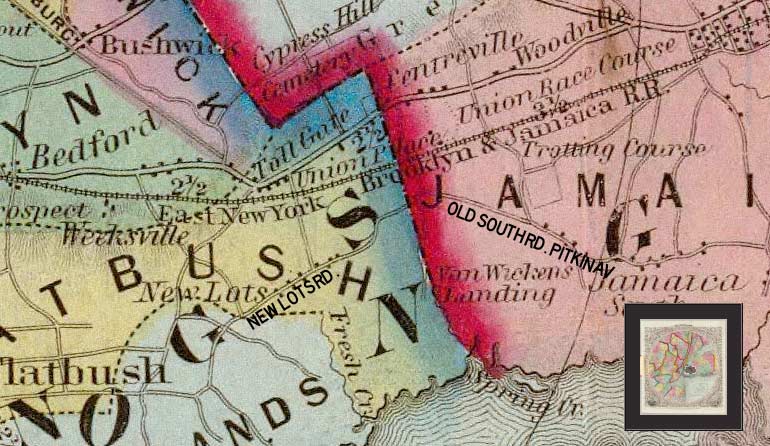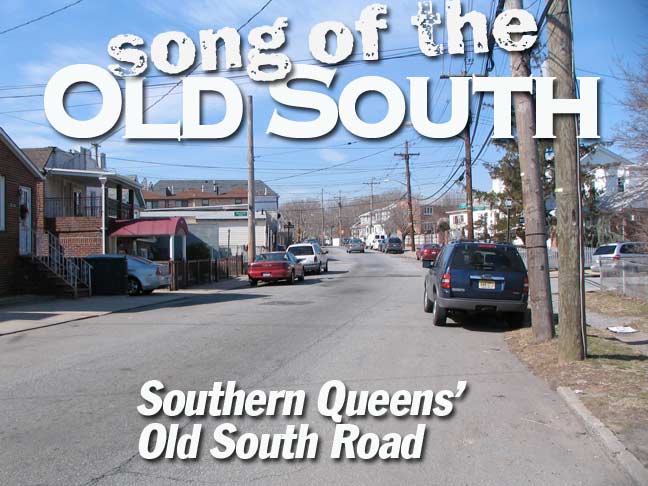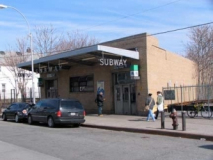Finding ancient routes throughout the five boroughs has been challenging and rewarding for me. Some, like Broadway in Manhattan and the Bronx, or Kings Highway in Brooklyn, are just as busy, if not busier, than they were centuries ago when they were first initiated. Some are Native American trails that were based on wild animal traces. Others, like the Albany and Boston Post Roads in the Bronx or Kouwenhoven Lane in Brooklyn, are less obvious and require a lot of studying of property lines, old maps and aerial shots. Some have remained fairly intact from centuries ago, and have been incorporated into the street grid and given new names. Rocky Hill Road, Fresh Meadow Lane and today’s subject, Old South Road, all in Queens, all into that latter category.
Old South Road, until it was supplanted by the Belt Parkway and its service roads, North and South Conduit Avenues, was the major east-west route in southern Queens from the Kings-Queens border east and southeast to Cornell Creek, the stream that runs between Baisley Pond in Baisley Park and Jamaica Bay. It generally ran north of the watercourse, or conduit, that connected Ridgewood Reservoir and the Brooklyn Water Works in western Suffolk County, but it likely predated it as far back as the colonial era. Its name is self-evident but for decades it probably went nameless, until people started calling it “the old south road.”
Old South Road’s trace can be plotted out in the paths of Pitkin Avenue, Albert Road, two pieces of it (that are over a mile apart) still called Old South Road), 130th Street, and 135th Avenue. On this page, I’ll provide views of the old road and what can be found there in the modern era.

This is an excerpt of a J.H. Colton map of eastern Brooklyn and southern Queens from 1865, though the map was first prepared in 1846 and might not have changed much from that earlier edition. I have marked the routes of Old South Road and New Lots Road (now Avenue, in Kings County). The map also shows what became Jamaica Avenue as well as the race tracks then prevalent in southwestern Queens. Some names on the map are still in use, such as Bushwick, East New York, Flatbush and New Lots. It is likely that there was a connection between New Lots Road and Old South Road, but that faded away as the overall street grid was built in the very early 20th Century.
The road down Old South Road for me begins at the Grant Avenue subway exit on Grant near Pitkin. This was one of the last of the classic IND-type stations when it opened in 1956 to connect the 8th Avenue-Fulton Street line with the eastern portion of the old Fulton Street el, which had shadowed Pitkin for many years but was cut back to the Brooklyn-Queens line in the 1940s. Stately PS214 can be found at Pitkin Avenue and Forbell Street.
RIGHT: homes on Drew Street, one block west of the Queens line on 75th Street. Further south several streets here carry gem names, such as Ruby, Amber, Emerald and formerly, Sapphire.
There is supposedly the shell of an IND subway stationunder Pitkin Avenue at 76th Street — but no definitive discovery has yet been made.
Ready to embark on Old South Road, but first let me show you maps from 1907 and 1909 respectively that show it as it was then in southwestern Queens. On both maps, I have circled in red an extant piece of the road. Interestingly, the east-west avenues of East New York in Brooklyn come to a stop just east of the borough line, but that wasn’t always the case as they were mapped to continue blithely on into southern Jamaica. Then came the 1920s Queens street numbering, which put an end to that notion except for Sutter Avenue, which runs all the way to 150th Street. Today, Blake, Belmont, Glenmore edge into Queens ever so slightly, while Pitkin and Liberty continue on for miles.
The westernmost existing piece of Old South Road runs between 76th and 77th Streets north of Pitkin Avenue. What likely saved it is those two houses you see on the photo above right.
This short piece of Old South Road was illuminated by a reflector-less mercury-bulb lamp dating to 1963 or so until just a couple of years ago, when it fell victim to a city-wide lamp replacement policy — these days [2011] NYC lampposts carry a uniform luminaire, which has never happened before.
This piece of OSR takes a slight southeast jog, which is significant…
… as Pitkin Avenue takes over Old South Road’s old route at 80th Street and begins a steep southeast run past Mokom Sholom, Acacia and Bayside Cemeteries, ending at Centreville Street and the Aqueduct Racetrack. This old house (which looks newer from the residing) likely stood on Old South Road when it was known by that name.
Three ancient Jewish cemeteries, in various states of repair or disrepair, lie between 80th and 84th Streets: Mokom Sholom, Bayside, and Acacia. At one time the entire space was Bayside Cemeterry, named for its proximity to Jamaica Bay and has nothing to do with the northeast Queens neighborhood.
One of the tallest and largest American flags and flagpoles I’ve seen can be found at a well-disguised cell phone relay station and tower carved out of one of the cemeteries at Pitkin Avenue and 81st Street. The flag is twelve feet in length. Though the unsightly relay equipment is well concealed, the huge pole met with initial resistance from the local community board when first proposed.
A yellow Pennsylvania (license plate in rear) Bug and scenes from Bayside Cemetery. The cemetery, owned by a Manhattan congregation, has come under fire for neglect in recent years, with ghouls entering the sarcophagi and molesting the interred. Vandalism is an ever present problem and barbed wire rings the top of the aluminum fences. In late 2010 progress was beginning to be made, but both Bayside and Acacia Cemteries remain weed choked in summer.
At 83rd Street, Sutter Avenue arrives to intersect Pitkin but doesn’t quite cross it, as the cemetery interrupts it for one block before it resumes. Both 83rd and 84th between Sutter and 133rd Avenues are lined with wellkept tidy houses, a planned development known as Tudor Village. The gateposts were donated by Ottaviano, a local monument manufacturer.
According to the Tudor Village website the development was established in 1929, so 2011 [when this was written] is actually their 82nd anniversary. The homes are more Tudor-ish on 84th Street.
The Old South Road, which has been called Pitkin Avenue for over a century now, rolls on at 85th Street, where you can find this tidy trio. Small plots and small houses are the hallmark of the side streets of Woodhaven and its southern cousin Ozone Park.
At 133rd Avenue’s intersection with Pitkin Avenue I found two lampposts installed just a few feet apart, with both installed in the 1970s.
When I began visiting Ozone Park on bike rides from Bay Ridge in the mid-1970s the street layout of the area was still in flux. Maps from the 1970s do not show 133rd Avenue running continuously through the neighborhood, and the street was not likely completed until the late 1960s-early 1970s (area residents, please fill me in). Maps always lag a bit behind.
At one time there must have been a plan to either widen or narrow 133rd Avenue after it had been finished, and a lamppost was placed in front, where the road was to be narrowed, or placed further back, so the road could be widened. My feeling is that the funds weren’t there, and while a lamppost was installed, the road work wasn’t completed.
ForgottenFan “Lenny”: 133rd Ave, and, indeed Pitkin Ave, and Desarc Rd were not continuous streets through OZ until 1975 or so. Gold Rd went through, but was not paved in the area where it met 89th Street. Before then, they were interupted by Balam farms, a creek, a play street (between Sitka and Silver-great for roller hockey), and two huge steep hills at 87th Street on one side of Pitkin, and 133rd Ave on the other.
Congressman Addabbo’s house was pretty much on a cliff back then. The area betwwen Silver Rd and The Farm, later a ballfield, (would’ve been Desarc, if it went through) was know to kids my age then as Shit Valley, and it had a creek/stream, many tree’s , and always smelled like….well, you can guess. Much of the area between Silver and Desarc was confiscated for growing vegetables, and football! There were cows down where Desarc, 133 and Pitkin and 88th now meet. Between Pitkin and the Conduit was forest, a huge ball field we called Conduit, and a smaller one called Box Oval, and a smelly factory.
Since I was last here the Department of Transportation has erected a new facilities maintenance building at Pitkin Avenue and 88th Street. The building itself is the usual issue for early 21st Century architecture, but the wall features an unusual 2009 art installation, “Cross-Section,” by artist Samm Kunce; another work of hers, “Under Bryant Park,” can be found in the passenger connection between the IND 6th Avenue and IRT Flushing Line subways at 42nd Street.
It’s disconcerting to see the mighty Linden Boulevard reduced to minuscule stubs on both sides of Pitkin Avenue at Sitka Street. Possibly in deference to Linden Boulevard’s magnificence both west and east of here, it rates not one but two street signs. No doubt there was at one time a plan to ram Linden Boulevard through and at one point, the work actually got started (another stub can be found on Desarc Road a block away). Maps from the 1960s show it running through. As it is, Linden Boulevard feeds traffic into the Belt Parkway, there’s another through section between Cross Bay Boulevard and Hawtree Avenue, and then from Rockaway Boulevard into Elmont, ending at the Southern State Parkway.
The story of why there is a Queens street named for Sitka, Alaska must be an interesting one, but I don’t know it. It belongs to a group of small streets that were on maps by the first decade of the 20th Century, existing today with mostly different names. A block way, Desarc Road is named for a small town in Arkansas; nearby Chicot Road is an Arkansas county. I’m grasping for a connection but I’m not sure I’ll find one.
Tudoresque attached houses, south side of Pitkin, east of Sitka Street. Right: can you guess which house is newer?
Traveling east, we have arrived at the point of Old South Road at the western end of it as shown on this 1909 map excerpt. As you can see there was once a plan on the drawing boards to extend several avenues east from East New York in Brooklyn, such as Hegeman, Vienna (which became Linden Boulevard in the 1920s) and Stanley Avenues, but that didn’t get past the planning. Cross Bay Boulevard, the main route to the Rockaways, opened across Jamaica Bay in 1925. The south part of the map, in light yellow, is now occupied by the Belt Parkway. From this point east, Albert Road assumes the Old South Road’s path until it reaches N. Conduit Avenue at Cohancy Street.
OLD SOUTH ROAD EAST: GOOGLE MAP
A very small bit of Old South Road branches from Pitkin Avenue to reach Cross Bay Boulevard. Within the last 40 years this has been called Van Wicklen Road (the name appears on several old area property atlases: see below).
Detouring down Redding Street and its monstrous Comfort Inn, you can find one of Queens’ many vest pocket cemeteries, found in the triangle formed by Redding Street, Albert Road and 149th Avenue: Southside Burial Ground. It was originally the family plot of the Van Wicklen farming family, who settled in Ozone Park in the 1660s and whose descendants lived here well into the 20th Century. The plot contains 79 graves, of which only four tombstones remain: Charles H. Monroe (d. 1872) and his brother Leander (d. 1873) share a stone; George Earney (d. 1909); Jannet, wide of Garret Van Wicklen (d. 1891); two stones have toppled to the ground and are unreadable. The property is fenced off and protected from vandalism (though not apparently well enough), and is apparently run by the NYC Parks Department, whose leaf symbol is posted on the fence. In addition to the Van Wicklens, many members of the Ryder and Stoothoff families are also interred here.
Albert Road and Redding Street, with some of the compact houses Woodhaven-Ozone Park is known for; you could probably impale yourself or cut a finger on one of those gables. Right: mangled sign, Albert Rd. and Cross Bay Boulevard.
When Ozone Park was named by developer Benjamin Hitchcock in the 1880s, ozone (O3, or three atoms of oxygen instead of two) didn’t have the negative connotations it does today with the ever-eroding atmospheric layer; a town called Ozone Park was cognate with, say, a Breezy Park, or Airy Park, a part of town that would be balmed by breezes off Jamaica Bay, which was completely unpolluted in the 1880s.
It’s not obvious in this photo by 149th Avenue and Albert Road, which assumes Old South Road’s path just east of Cross Bay Boulevard, criss-cross here, making for a confusing traffic pattern.
You won’t find it on most city maps, but this short dirt road running south from Albert Road just east of Cross Bay Boulevard is called Jaegers Lane, and it still has two properties on it. It has extended further south into the very early 2000s, but a housing project was constructed there, obliterating its southern section.
Old South…er, Albert Road presses further east here at 94th Street. The Centreville Playground, and Centreville Street, are named fora former area horse racing track.
Upon reaching Huron Street, Albert Road enters something of a wasteland, with lage plots of empty, unfenced grassy areas, not built upon. Some are fenced off, with frequent “no trespassing” signs abounding. I suspect these empty areas have something to do with either nearby Aqueduct Racetrack or aircraft approach routes for Kennedy Airport, but that doesn’t explain the no trespassing signs. What gives?
Similar barrenness can be found along Cohancy Street, Hawtree Avenue and Eckford Avenue, all north of Albert Road at its meeting with North Conduit Avenue. Again, why has nothing been built here?
Albert Road ends quietly, at North Conduit Avenue and the Cohancy Street overpass over the Belt Parkway. Cohancy leads south to Howard Beach, land of mobsters, which I avoid out of principle, though someday I will have to venture therein. The ghost of a service station looms menacingly at North Conduit and Cohancy.
There is actually a subway entrance here, to the A train Aqueduct-N. Conduit station, one of the obscurer subway stops. This part of the A train was purchased from the Long Island Rail Road in the 1950s and re-gauged for the subway. Further north there is anAqueduct Racetrack station. There used to be a special express train running from here along the Fulton Street-8th Avenue IND to alower level platform at the 8th Avenue-42nd Street station, which is now being demolished so a western extension of the IRT Flushing Line can be run through.
East of the A train, Old South Road follows the course of North Conduit Avenue but between there and 125th Street its route has been eliminated by the Belt Parkway. Much of the map above from 1909 was laid out as shown here, but the streets are numbered instead of named; east-west avenues were going to be eastern extensions of avenues in Brooklyn’s East New York, while north-south streets generally were named in alphabetical order. We missed out on interesting street names like Klondike, Lizard and Wabash. Lefferts Boulevard still runs north to south, while parts of Hawtree Creek road still interrupt the grid. The portion of Old South Road that I circled is still there, since the Belt Parkway took a jog north at that point, sparing it.
South of the Belt Parkway, Old South Road, this time using its own name, begins again at 125th Street and South Conduit Avenue, running east a few locks to 130th Street. At that point the old rod turned, running directly north past the conduit again, and then abruptly east again, at 135th Avenue.
Maps of 1909 and 2011 of Old South Road from Van Wyck Blvd. (Expressway) and 146th Street. The old road persists today as 135th Avenue, following the same humpbacked route. The old aqueduct conduit has been replaced by the Belt Parkway and North & South Conduit Avenues.
Above left: 135th Avenue and 135th Street, the highest number in Queens where the Avenue and Street number are the same. Right: 144th Street and 135th Avenue, showing the jog to the southeast Old South Road takes.
Left: 135th Street meets North Conduit Avenue at 146th Street, marking the easternmost spot any remnant of Old South Road can be spotted. The road proceeded east here along the route of the Belt Parkway to 150th Street, which before Queens’ street numbering was called Three Mile Mill Road in a region known as Idlewild Park, which gave rise to Kennedy Airport’s original name.
3/6/11




